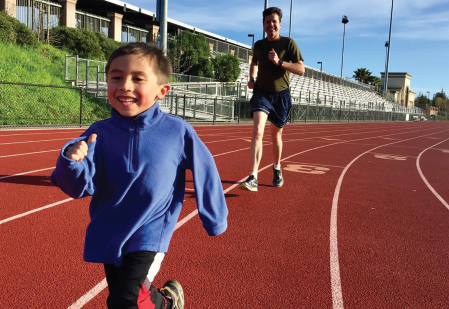Before the big race, my teammates and I huddled, stacked our hands and screamed like the pumped-up teenagers we were. Castro Valley High’s boys cross country team had an eight-year championship streak on the line in 1985, providing us abundant motivation and pressure to win our league meet. Though we ran our hearts out, rival San Leandro beat us by three points. The loss broke my 15-year-old heart.
Yet my teammates and I grew because of it, even if it took me years to see it that way. More than anything else, distance running taught me how to work hard in pursuit of self-improvement.
I turned 50 recently and I’m grateful to still enjoy outdoor activities that I picked up in my youth. Following are lessons I’ve learned over the years. This installment, the second of five, focuses on running.

Workouts work. After our crushing second-place finish, my friends and I learned to act less like teenagers when it came time to run. Our dedicated coaches led us on workouts after school, on weekends and during the summers, sometimes twice a day. Hard as it was, we improved every year, winning five track and cross country league championships and reaching the state meet. We had the time of our lives. Put in enough effort to improve. You won’t regret it.
Running and other aerobic activities improve your health and quality of life. You don’t have to be a competitive athlete to enjoy the benefits. Talk to folks you know who run casually a few times a week. I’m sure they will agree that the activity makes them healthier and happier.
To help your body recover, alternate easy and harder workouts. Take time to stretch. Increase mileage gradually by no more than 10 percent per week. Run on trails or dirt roads instead of pavement when possible. Replace your shoes every 500 miles; the expense is worth it. All these become more important the older you get.
Embrace the personal record (PR). Part of the beauty of running is that everyone can measure improvement individually. PRs document a runner’s progress and motivate continued effort. That’s true for races as well as workouts, if you run the same route often.

Write down your workouts to document progress and motivate yourself. When you know to the second how long a certain run took before, beating that mark brings a burst of happiness. Plus, it’s harder to skip a day when you have to confess to your logbook. Same goes for those who record their efforts electronically through Fitbit, Strava and the like.
Latch onto a running partner or group in your speed range or a little faster. This encourages a runner to keep training and improve, not to mention helps one to make friends. In both high school and college, I made most of my best friends through running, and we’re still close today.
Participate in a race once in a while, even if you don’t consider yourself competitive. Racing validates your effort and will encourage you to keep training. Plus, you will collect race T-shirts that impress your friends.
If you want some age-group medals to go with those race shirts, get on the track to run intervals once or twice a week. The length and speed depend on your goals, but in general, run shorter repetitions than your race distance (400 meters, for instance) and faster than your target race pace. The improvement this generates addicts many runners, and you could be one of them.
Mind your pace. In workouts or races, most runners start and finish faster than they run in the middle of their distances. You can pick up time by minimizing that loss and running an even pace. Your prior workouts and race times (which you wrote down, right?) will help you determine your optimum pace.
Set goals and strive to achieve them. Whatever your level of ability, there’s a benchmark that’s challenging yet within reach. The bigger the goal, the better you will feel when you achieve it. In college, I labored to set my lifetime marks in the 800, 1,500 and 5,000 meters. These forced years of strenuous effort but thrilled me when I finally succeeded. Breaking 5 minutes in the mile motivated me as a high school sophomore, and now 35 years later, I covet the mark again.

My weekly running increased from 20 miles to 50 miles. I ran intervals and long off-campus runs with the track kids from Castro Valley High, where I’m now a teacher. I built up from 5Ks to 10Ks and half-marathons. My times steadily improved as I lost 20 pounds.
After two years, I entered the Napa Marathon with the goal of breaking three hours. For the first 20 miles, I paced 6 minutes and 30 seconds per mile as planned. The final six miles slowed me down quite a bit but I managed to finish in 2 hours, 57 minutes and 58 seconds, exhausted and delighted.
I realized later that I hydrated and fueled insufficiently on the long course, a beginner’s mistake. The experience proved to me that I still have more to achieve and learn as a runner. As my midlife comeback continues, I’m looking forward to doing both.
— This is Part 2 in the 50 lessons in 50 years series.
Part 1 in the series, titled “Winter Wisdom” is available in the February/March 2020 issue and at 209magazine.com.





